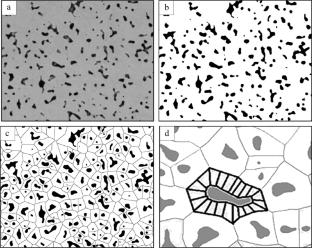Changes in the porous structure of compacts produced from carbonyl iron and a mixture of iron with doping additions (4 wt.%) with increasing holding time at 900°C were analyzed. The compacts were sintered in a hydrogen atmosphere for 5, 10, 15, and 30 min. Powders of carbonyl iron, nickel, and ferroalloys (Fe–Si, Fe–Cr, Fe–Mo) were the starting materials. The structural parameters (characteristic pore size and radius of conditional particles) were evaluated from computer processing of electron microscopy images. The experimental studies found that the average characteristic pore size in the samples of carbonyl iron and those with doping additions changed differently during sintering, especially in the first minutes. The carbonyl iron samples had 2% higher porosity than that of the doped ones after 5 min of sintering but became 9.5% lower after 15 min. This can be explained by a significant change in the interaction between pores in the homogenization process in the samples with doping additions at the beginning of sintering. A stage with uneven pore filling resulting from local chemical inhomogeneity was revealed. To describe the metal component of the porous structure, the radius of conditional particles was chosen. This parameter increased 4.7 times faster for pure carbonyl iron than for doped carbonyl iron during sintering. The experimental studies showed that the relationship between the radius of conditional particles and the porosity of the samples was hyperbolic and determined by the size of the starting powders. The coefficients of this relationship, experimentally found for a material of specific chemical composition, can be used to describe the sintering of materials with similar chemical compositions.



